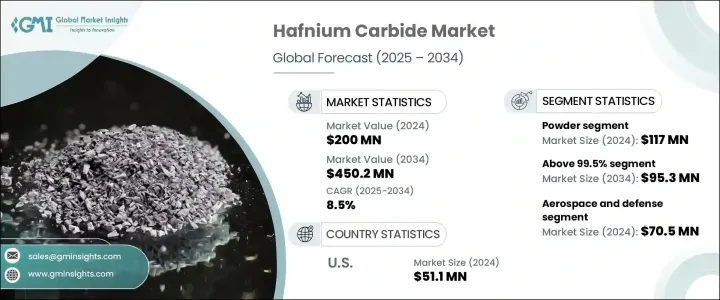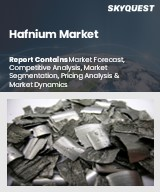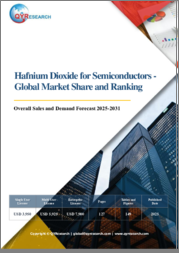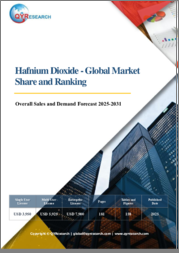
|
시장보고서
상품코드
1750458
세계의 하프늄 카바이드 시장 : 기회, 성장 촉진요인, 산업 동향 분석 및 예측(2025-2034년)Hafnium Carbide Market Opportunity, Growth Drivers, Industry Trend Analysis, and Forecast 2025 - 2034 |
||||||
세계의 하프늄 카바이드 시장은 2024년에는 2억 달러로 평가되었고, 2034년에는 4억 5,020만 달러에 이를 것으로 예측되며, CAGR 8.5%로 성장할 전망입니다.
하프늄 카바이드의 초고온 용융점(약 3,958°C)은 현대 공학에서 알려진 가장 열에 강한 재료 중 하나로 자리매김했습니다. 극한 환경에서의 내구성은 최대 열 내성, 마모 저항성, 구조적 안정성이 요구되는 산업 분야에서 그 중요성이 점점 더 부각되고 있습니다. 방위, 에너지, 반도체, 재료 공학 등 산업 분야는 하프늄 카바이드의 고급 특성을 활용해 빠르게 채택하고 있습니다.

이 채택 급증은 화학적 불활성과 부식성 또는 고압 환경에서도 안정성을 유지하는 능력에 기인합니다. 우수한 경도와 고온 성능을 갖춘 하프늄 카바이드는 차세대 기술의 선호 재료로 자리매김하고 있습니다. 특히 기계적 강도, 내구성, 열전도율이 필수적인 응용 분야에서 그 역할이 두드러집니다. 기술이 계속 발전함에 따라 하프늄 카바이드는 엄격한 운영 조건에서 신뢰성을 중시하는 고위험 산업 분야에서 주목받고 있습니다.
| 시장 범위 | |
|---|---|
| 시작 연도 | 2024년 |
| 예측 연도 | 2025-2034년 |
| 시작 금액 | 2억 달러 |
| 예측 금액 | 4억 5,020만 달러 |
| CAGR | 8.5% |
2024년 기준 분말 형태가 시장 점유율의 58.5%를 차지하며 1억 1,700만 달러의 가치를 기록했습니다. 하프늄 카바이드 분말에 대한 선호도가 증가하는 이유는 복잡한 시스템, 특히 고온에서 작동하는 구조용 복합재료 및 코팅에 유연성과 통합 용이성을 제공하기 때문입니다. 분말 기반 하프늄 카바이드의 적응성은 적층 제조 및 표면 처리 분야에서 그 활용을 확대시키고 있습니다. 한편, 전자 및 반도체 분야에서의 수요는 고기술 환경에서 박막 증착 및 정밀 미세 가공 기술 지원을 통해 지속적으로 증가하고 있습니다.
항공우주 및 방위 산업은 2024년 시장 점유율의 35.3%를 차지하며 7,050만 달러를 기록했습니다. 극한의 열 부하와 기계적 스트레스에 견디는 무적의 능력으로 인해 하프늄 카바이드는 고속 차량과 고급 보호 시스템의 핵심 부품으로 계속 선호되고 있습니다. 또한 세라믹 산업은 절삭 도구와 구조 요소 제조 시 강도와 마모 저항성으로 인해 이 재료의 사용을 확대하고 있습니다.
미국의 하프늄 카바이드 시장은 2024년 5,110만 달러를 기록했으며, 2034년까지 9%의 연평균 성장률(CAGR)로 성장할 것으로 예상됩니다. 이 성장은 초고온 세라믹스에 대한 수요 급증에 힘입고 있습니다. 항공우주 및 방위 프로그램이 재료 성능의 한계를 돌파함에 따라, 하프늄 카바이드가 극한의 열적 및 기계적 스트레스에 견딜 수 있는 능력으로 인해 점점 더 선호되고 있습니다. 군사 등급 시스템에서는 고급 열 보호 및 추진 부품에 적용되고 있습니다. 동시에 반도체 산업은 고온 및 화학 노출 환경에서 안정성이 필수적인 박막 기술과 마이크로전자 구조에 하프늄 카바이드를 통합하고 있습니다.
목차
제1장 조사 방법과 범위
제2장 주요 요약
제3장 업계 인사이트
- 생태계 분석
- 밸류체인에 영향을 주는 요인
- 이익률 분석
- 혁신
- 장래의 전망
- 제조업자
- 리셀러
- 트럼프 정권에 의한 관세에 대한 영향
- 무역에 미치는 영향
- 무역량의 혼란
- 보복 조치
- 업계에 미치는 영향
- 공급측의 영향(원재료)
- 주요 원재료의 가격 변동
- 공급 체인 구조
- 생산 비용에 미치는 영향
- 공급측의 영향(원재료)
- 수요측의 영향(판매가격)
- 최종 시장에의 가격 전달
- 시장 점유율 동향
- 소비자의 반응 패턴
- 영향을 받는 주요 기업
- 전략적인 업계 대응
- 공급망 재구성
- 가격 설정 및 제품 전략
- 정책관여
- 전망과 향후 검토 사항
- 무역에 미치는 영향
- 무역 통계(HS코드)
- 주요 수출국(2021-2024년)
- 주요 수입국(2021-2024년)
참고 : 위의 무역 통계는 주요 국가에 대해서만 제공됩니다.
- 공급자의 상황
- 이익률 분석
- 주요 뉴스와 대처
- 규제 상황
- 영향요인
- 성장 촉진요인
- 항공우주 및 방위 산업의 성장
- 고온 응용 분야에 대한 수요 증가
- 반도체 산업의 진보
- 원자력 산업에서의 채택 증가
- 업계의 잠재적 위험 및 과제
- 높은 생산 비용
- 원재료 공급 부족
- 복잡한 제조 공정
- 대체 재료의 경쟁
- 성장 촉진요인
- 시장 기회
- 재생 에너지 분야의 신흥 응용 분야
- 적층 제조 기술의 발전
- 나노 복합 재료 연구 개발
- 신흥 경제국에서의 수요 증가
- 성장 가능성 분석
- Porter's Five Forces 분석
- PESTEL 분석
제4장 경쟁 구도
- 소개
- 기업의 시장 점유율 분석
- 경쟁 포지셔닝 매트릭스
- 전략적 전망 매트릭스
제5장 시장 추계 및 예측 : 제품 유형별(2024-2034년)
- 주요 동향
- 분말
- 스퍼터링 타겟
- 과립
- 기타
제6장 시장 추계 및 예측 : 순도별(2024-2034년)
- 주요 동향
- 99% 미만
- 99-99.5%
- 99.5% 이상
제7장 시장 추계 및 예측 : 용도별(2024-2034년)
- 주요 동향
- 항공우주 및 방위
- 세라믹
- 전자 및 반도체
- 원자력 에너지
- 산업
- 기타
제8장 시장 추계 및 예측 : 지역별(2024-2034년)
- 주요 동향
- 북미
- 미국
- 캐나다
- 유럽
- 영국
- 독일
- 프랑스
- 이탈리아
- 스페인
- 아시아태평양
- 중국
- 인도
- 일본
- 한국
- 호주
- 라틴아메리카
- 브라질
- 멕시코
- 아르헨티나
- 중동 및 아프리카
- 아랍에미리트(UAE)
- 사우디아라비아
- 남아프리카
제9장 기업 프로파일
- Advanced Engineering Materials
- American Elements
- Ereztech
- Hunan Huawei Jingcheng Material Technology
- Merck
- Nanografi Advanced Materials
- Otto Chemie
- Pacific Particulate Materials
- Stanford Advanced Materials
- Starsky international holdings
The Global Hafnium Carbide Market was valued at USD 200 million in 2024 and is estimated to grow at a CAGR of 8.5% to reach USD 450.2 million by 2034, driven by the demand for hafnium carbide continues to rise due to its remarkable mechanical, thermal, and electrical performance under extreme conditions. Its ultra-high melting point, close to 3958°C, positions it among the most heat-resistant materials known in modern engineering. Its robustness in severe environments has made it increasingly relevant in industries requiring maximum thermal tolerance, wear resistance, and structural integrity. Markets such as defense, energy, semiconductors, and materials engineering are rapidly adopting hafnium carbide for its advanced characteristics.

This surge in adoption is attributed to its chemical inertness and the ability to remain stable in corrosive or high-pressure environments. With its superior hardness and high-temperature capabilities, hafnium carbide is carving a path as a preferred material for next-generation technologies. Its role is especially prominent in applications where mechanical strength, durability, and thermal conductivity are non-negotiable. As technological advancements continue to evolve, hafnium carbide has gained momentum across high-stakes sectors that prioritize reliability in demanding operational conditions.
| Market Scope | |
|---|---|
| Start Year | 2024 |
| Forecast Year | 2025-2034 |
| Start Value | $200 Million |
| Forecast Value | $450.2 Million |
| CAGR | 8.5% |
In 2024, the powder form dominated the market, contributing 58.5% of the total share and reaching a value of USD 117 million. The growing preference for hafnium carbide powder stems from its flexibility and ease of integration into complex systems, including structural composites and coatings that operate at elevated temperatures. The adaptability of powder-based hafnium carbide is pushing its use in additive manufacturing and surface treatments. Meanwhile, demand in electronics and semiconductors is steadily rising as the material supports thin film deposition and precision micro-fabrication techniques in high-tech environments.
The aerospace and defense segment held a significant portion of the market in 2024, generating USD 70.5 million and capturing a 35.3% share. With its unmatched ability to endure extreme thermal loads and mechanical stress, hafnium carbide continues to be favored for critical components in high-speed vehicles and advanced protective systems. Additionally, the ceramic sector is expanding its use of the material due to its strength and wear resistance in manufacturing parts like cutting tools and structural elements.
US Hafnium Carbide Market generated USD 51.1 million in 2024, with a projected growth rate of 9% CAGR through 2034. This expansion is fueled by a surge in demand for ultra-high-temperature ceramics in mission-critical sectors. As aerospace and defense programs push the boundaries of material performance, hafnium carbide is increasingly favored for its ability to endure extreme thermal and mechanical stress. In military-grade systems, it is being adopted for advanced thermal protection and propulsion components. Simultaneously, the semiconductor industry integrates hafnium carbide into thin film technologies and microelectronic structures, where stability under high heat and chemical exposure is vital.
Leading companies in the Global Hafnium Carbide Market focus on technological enhancement, supply chain optimization, and targeted partnerships to grow their market presence. Merck and Ereztech are advancing purity levels and refining particle size control for better product performance. American Elements and Advanced Engineering Materials are investing in material customization and expanding their high-temperature material portfolios. Hunan Huawei Jingcheng Material Technology is building distribution networks and strengthening relationships with aerospace and electronics clients. Together, these companies are working to meet growing demand across high-temperature and precision applications, enhancing their foothold in a highly specialized market segment.
Table of Contents
Chapter 1 Methodology & Scope
- 1.1 Market scope & definitions
- 1.2 Base estimates & calculations
- 1.3 Forecast calculations
- 1.4 Data sources
- 1.4.1 Primary
- 1.4.2 Secondary
- 1.4.2.1 Paid sources
- 1.4.2.2 Public sources
Chapter 2 Executive Summary
- 2.1 Industry synopsis, 2021-2034
Chapter 3 Industry Insights
- 3.1 Industry ecosystem analysis
- 3.1.1 Factor affecting the value chain
- 3.1.2 Profit margin analysis
- 3.1.3 Disruptions
- 3.1.4 Future outlook
- 3.1.5 Manufacturers
- 3.1.6 Distributors
- 3.2 Trump administration tariffs
- 3.2.1 Impact on trade
- 3.2.1.1 Trade volume disruptions
- 3.2.1.2 Retaliatory measures
- 3.2.2 Impact on the industry
- 3.2.2.1 Supply-side impact (raw materials)
- 3.2.2.1.1 Price volatility in key materials
- 3.2.2.1.2 Supply chain structure
- 3.2.2.1.3 Production cost implications
- 3.2.2.1 Supply-side impact (raw materials)
- 3.2.3 Demand-side impact (selling price)
- 3.2.3.1 Price transmission to end markets
- 3.2.3.2 Market share dynamics
- 3.2.3.3 Consumer response patterns
- 3.2.4 Key companies impacted
- 3.2.5 Strategic industry responses
- 3.2.5.1 Supply chain reconfiguration
- 3.2.5.2 Pricing and product strategies
- 3.2.5.3 Policy engagement
- 3.2.6 Outlook and future considerations
- 3.2.1 Impact on trade
- 3.3 Trade statistics (HS code)
- 3.3.1 Major exporting countries, 2021-2024 (kilo tons)
- 3.3.2 Major importing countries, 2021-2024 (kilo tons)
Note: the above trade statistics will be provided for key countries only.
- 3.4 Supplier landscape
- 3.5 Profit margin analysis
- 3.6 Key news & initiatives
- 3.7 Regulatory landscape
- 3.8 Impact forces
- 3.8.1 Growth drivers
- 3.8.1.1 Growing aerospace and defense applications
- 3.8.1.2 Increasing demand for high-temperature applications
- 3.8.1.3 Advancements in semiconductor industry
- 3.8.1.4 Rising adoption in nuclear energy sector
- 3.8.2 Industry pitfalls & challenges
- 3.8.2.1 High production costs
- 3.8.2.2 Limited raw material availability
- 3.8.2.3 Complex manufacturing process
- 3.8.2.4 Competition of alternative materials
- 3.8.1 Growth drivers
- 3.9 Market opportunities
- 3.9.1 Emerging applications in renewable energy
- 3.9.2 Advancements in additive manufacturing
- 3.9.3 Research and development in nanocomposites
- 3.9.4 Growing demand in emerging economies
- 3.10 Growth potential analysis
- 3.11 Porter's analysis
- 3.12 PESTEL analysis
Chapter 4 Competitive Landscape, 2024
- 4.1 Introduction
- 4.2 Company market share analysis
- 4.3 Competitive positioning matrix
- 4.4 Strategic outlook matrix
Chapter 5 Market Estimates & Forecast, By Product Type, 2021-2034 (USD Million) (Kilo Tons)
- 5.1 Key trends
- 5.2 Powder
- 5.3 Sputtering target
- 5.4 Granules
- 5.5 Others
Chapter 6 Market Estimates & Forecast, By Purity, 2021-2034 (USD Million) (Kilo Tons)
- 6.1 Key trends
- 6.2 Less than 99%
- 6.3 99% - 99.5%
- 6.4 Above 99.5%
Chapter 7 Market Estimates & Forecast, By Application, 2021-2034 (USD Million) (Kilo Tons)
- 7.1 Key trends
- 7.2 Aerospace and defense
- 7.3 Ceramic
- 7.4 Electronics and semiconductor
- 7.5 Nuclear energy
- 7.6 Industrial
- 7.7 Others
Chapter 8 Market Estimates & Forecast, By Region, 2021-2034 (USD Million) (Kilo Tons)
- 8.1 Key trends
- 8.2 North America
- 8.2.1 U.S.
- 8.2.2 Canada
- 8.3 Europe
- 8.3.1 UK
- 8.3.2 Germany
- 8.3.3 France
- 8.3.4 Italy
- 8.3.5 Spain
- 8.4 Asia Pacific
- 8.4.1 China
- 8.4.2 India
- 8.4.3 Japan
- 8.4.4 South Korea
- 8.4.5 Australia
- 8.5 Latin America
- 8.5.1 Brazil
- 8.5.2 Mexico
- 8.5.3 Argentina
- 8.6 MEA
- 8.6.1 UAE
- 8.6.2 Saudi Arabia
- 8.6.3 South Africa
Chapter 9 Company Profiles
- 9.1 Advanced Engineering Materials
- 9.2 American Elements
- 9.3 Ereztech
- 9.4 Hunan Huawei Jingcheng Material Technology
- 9.5 Merck
- 9.6 Nanografi Advanced Materials
- 9.7 Otto Chemie
- 9.8 Pacific Particulate Materials
- 9.9 Stanford Advanced Materials
- 9.10 Starsky international holdings



















